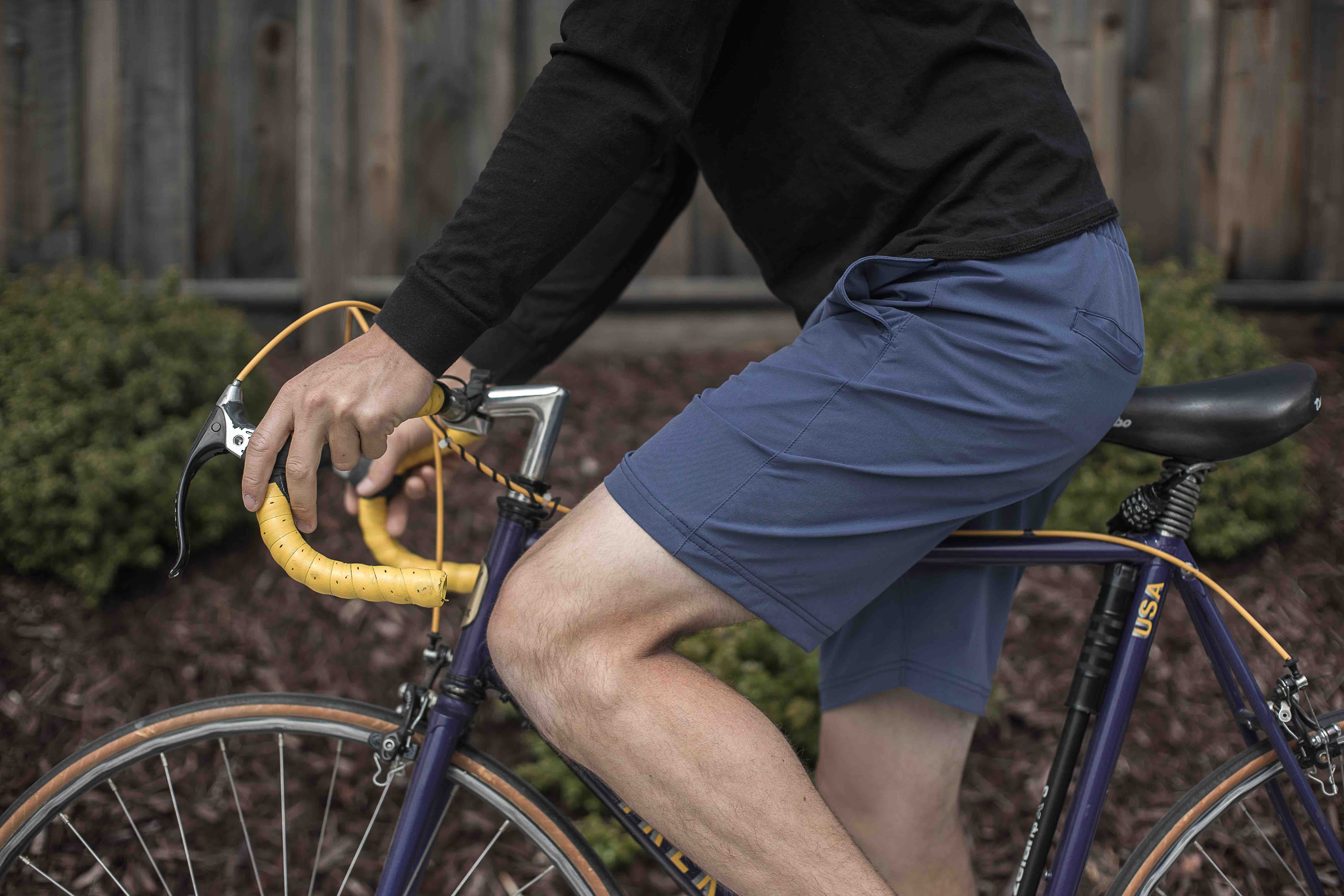These 8 Companies Share Their Tips To Run A Successful Kickstarter Campaign
1. Treat your Kickstarter as a way to validate your idea
Once you've got that "a-ha moment" you're likely to get more proof before contacting manufacturers, designers and suppliers.
You really want to ask yourself "does anybody want this that I just thought about"? And Kickstarter is one of the best ways to test that. Running a crowdfunding campaign can give you a sense on the level of interest people can have in your product.
Paul started Spuds, a men’s performance apparel, by raising their initial funds on Kickstarter the past Summer 2017.
Kickstarter is an excellent platform for being able to start up a company.
It allows you to create your Minimum Viable Product (MVP) and both test it with a centralized audience and to get funding without investing huge amounts into production and then finding the people to sell them to.
We have been able to produce our first production of our Classic Shorts (and already start on our 2nd!) all while gaining the funds for it from people who believe in the concept of what we are doing, and already having them sold and ready to ship by the time we were producing.

2. Get The Pricing Right
This is a key element of any Kickstarter campaign. There are many factors to keep in mind when pricing your rewards. Make a budget, run your numbers several times, have them checked by a colleague or a fellow entrepreneur.
Have you kept in mind the boxes, tape, working hours and possible international shipping? Forgetting any of these elements can turn your successful campaign into a nightmare.
Also, going back to the kind of audience that Kickstarter has, don't underestimate yourself! You're providing value, you're solving a problem, you're addressing an audience of innovators and people looking to get the latest of the latest of tech and design in their hands. If your product is right, they're probably more than willing to pay what a first run of your product is worth, you don't need to launch with a discounted price.
Leaving money on the table is probably one of the worst things that can happen to any entrepreneur.
The entire project has been self-funded. Kickstarter was a primary source but this can be a tricky medium to use. The 2 main errors that we made were underpricing the product and not pre-campaigning long enough. People on Kickstarter expect to pay slightly more to be the first to own a product, if we were to have done this again I’d price the product higher.

3. Hit The Ground Running
Having the most beautiful video, pictures and great detailed text is not going to mean anything if you don't do your pre-launch homework. You can't just really expect Kickstarter to do all the work for you. There are hundreds of campaigns launching everyday, and Kickstarter will pay attention and promote those who perform well in the initial moments, so you really need to work to stand out from the crowd.
Your Kickstarter campaign starts really long time before you hit the "launch" button. You need to prepare impressive media, copywriting ... and have a hungry crowd ready. Or at least a bunch of people interested in your product that you can alert once you're live.
These can come in various forms and there's not really a right way of doing it. You can start an Instagram account, a blog, a Facebook group, or piggyback on an online community that already exists. Explore your options, try different things and push the one that is working best for you.
The people from Trini Pepper Sauce won the sympathy of a reddit community and that allowed them to hit the ground running and ended up getting almost 5 times their goal.
We researched hacks to make our campaign go viral and to be selected as a Kickstarter favorite to be promoted.
The hacks included doing a promotional free sample through reddit. We learned from caps. hot seven that a four month buffer period between the initial promotional post and Kickstarter post on reddit is effective in generating Kickstarter traction and we learned from FYM Hot Sauce that cross-posting between subreddits also helped in drawing additional demographics to the Kickstarter.
After the Kickstarter page was finished we launched the product by email blasting our list that we obtained from doing the sample campaign.
People loved the product from tasting the samples and were waiting to order as soon as we launched. Our campaign was quite successful and we used all what we learned from the sample batch to produce our subsequent batches for our Kickstarter backers.

4. Make An Awesome Video
Competition on Kickstarter is fierce and to get the backers' attention you need to stand out ... for the good reasons. Your campaign page needs to be tip-top, and that includes stylish pictures and videos.
A moving video that explains the problem that you're solving and it's also shareable can go a long way. You need to put your campaign in front of as many people as possible, and this is one great way to do it.
When I was making units out of the garage, we started selling them at local street fairs and trade shows. Once we got production going we ran a Kickstarter campaign and raised over $400,000. We got pretty lucky with our Kickstarter and had a video go viral and get over 36,000,000 views on Facebook. That kicked the business into high gear from that point on.
5. Get Hype
Kickstarter campaigns are limited in time. You have between 30 and 60 days to raise your funds, so there's no time to waste! You want to drive attention to your campaign as quickly as possible and keep the visits coming.
Common strategies include Facebook or Instagram Ads, writing blog posts, etc. But you can go crazy here, this is the place and time to try new things, like the people from Woodies, who hire no less than Kendall Jenner to shoot their promotional pictures.
Plus, you can train your negotiation skills with influencers and their managers. Which will come handy for your conversations with suppliers and manufacturers.
I set my sights high and decided I wanted to hire Kendall Jenner for the video shoot. It started out as a joke really.
My friend was kind of daring me to find out what her rate was. I just called her management, and next thing you know I’m negotiating with her agent.
I got them down from 150k to 25k. 25k was just about all the money I had in the world, but I bet it on this idea. At this point, I’m basically the dude from Fyre Festival, walking around pretending like I had enough money to pull this off.
I hired a really good photographer, videographer, hair, makeup, extra set hands, cool locations, classic cars, plane tickets, it was SO CRAZY, but somehow I pulled it off.

If you don't have that kind of budget available, you're going to need to think in other ways of driving attention to your campaign.
Craig, from The Airhook, did an excellent job on that:
The Airhook had a funding goal of $15,000 / $20 pledge per user = 750 backers needed. How in the world are we going to get 750 backers?!? The first misconception is what your network will do. In my case, I had 900 friends on Facebook, 1200 connections on LinkedIn, and 300 Twitter followers – that should do it, right?!? No.
Here is how we interpreted these numbers.
2,400 total network 10% of these people will click on the Kickstarter link I send to them = 240 visits 10% of these people will pledge = 24 backers
Wait – we still need 726 more backers to reach our goal! You need to focus on the real driver of any good crowd-funding plan… influencers.
Influencers are anyone who has a voice in your product's industry that can spread the word about your product to their greater networks. For The Airhook, this was travel bloggers, product reviewers, Twitter & Instagram accounts with a travel focus (and over 500K followers), etc.
All you need to do is a simple search like below – and this is only the top couple hits! It’s that easy!

Since this information is free and available [to your competition], it is important to think outside the box and find an influencer who can relate to your story/products. Make a list and reach out to all of them, if 10% respond with interest, you are doing well and telling a strong story.
6. Keep People Informed And Engaged
Running a campaign is not a one-time effort anymore. To run a successful campaign you can't simply launch it and wait until it's finished hoping that you will get the funding. This is a full 30-day effort where you need to keep the information flowing.
You don't want to be the kind of person flooding the internet we the same message just announcing that you have a Kickstarter campaign running. It's essential that you publish regular updates on your blog, website, social media and/or campaign page.
This will convey an image of trust because you didn't go silent after getting people's money, and will be useful to both your current backers, which are interested on how the campaign is going; and to help you attract new possible backers thanks to these updates.
You can do this in several ways: writing posts, uploading videos or even recording a podcast! Whatever you feel most comfortable with.
To make sure that we actually stuck to it, we decided to create a weekly podcast where we would check in with our status and goals, all the way up until the campaign launched. Even though our podcast didn’t have many listeners, it was an amazing way to keep ourselves accountable.
We ended up raising over $20,000 on Kickstarter and Game Night in a Can was born.

7. Capitalize Your Kickstarter Success On Other Platforms
Several studies have confirmed that Kickstarter performs better compared to Indiegogo, mainly because they have a brand that attracts and fosters their backer community, they have more organic traffic and conversion rate.
Kickstarter has always had a great focus has always been on delivering a great backer experience.
But, the fact that you've run a successful Kickstarter campaign doesn't mean you can't use other crowdfunding platforms. What if you reached your Kickstarter goal but are a bit short on budget of doing something really amazing? Indiegogo released a program on its platform that allows successful campaigns to continue selling indefinitely . Something like a pre-order shop. And it's not exclusive to Indiegogo campaigns. The service will copy your full Kickstarter page for you.
When a Kickstarter campaign is successfully funded, IndieGogo allows you to “roll over” the campaign on to their platform so you can keep accepting preorders, and acquiring more customers/awareness. I raised about $75k on Kickstarter, and another $33k on Indiegogo for about $108k in total crowdfunding sales.

Launching a product is always hard, is a long process that involves many areas of expertise beyond the design and creation of the product itself. And one of the most important is definitely funding. Samples can be expensive, so can be hiring a web developer, a designer or the legal paperwork. Fortunately, creators and innovators have many great ways to put their ideas out there and see if there is a potential audience for them before spending their own money.
Crowdfunding platforms are one of these amazing channels to showcase innovative products and get money from backers beforehand. Money that will allow supporting at least part of those expenditures we were talking about.
But as easy as it may seem, launching a successful crowdfunding campaign takes much more than just filling out the form and wait to receive the money. Lots of makers are fighting for the same attention and you need to know the insides of the process to increase your chances of reaching your funding goal.
This post is a handpicked compilation of tips and learnings from 8 companies that were successfully funded on Kickstarter.

Download the report and join our email newsletter packed with business ideas and money-making opportunities, backed by real-life case studies.

Download the report and join our email newsletter packed with business ideas and money-making opportunities, backed by real-life case studies.

Download the report and join our email newsletter packed with business ideas and money-making opportunities, backed by real-life case studies.

Download the report and join our email newsletter packed with business ideas and money-making opportunities, backed by real-life case studies.

Download the report and join our email newsletter packed with business ideas and money-making opportunities, backed by real-life case studies.

Download the report and join our email newsletter packed with business ideas and money-making opportunities, backed by real-life case studies.

Download the report and join our email newsletter packed with business ideas and money-making opportunities, backed by real-life case studies.

Download the report and join our email newsletter packed with business ideas and money-making opportunities, backed by real-life case studies.









